It’s Martin in the ‘home’ stretch!
National Guard pro mounts last-minute charge to win at Okeechobee
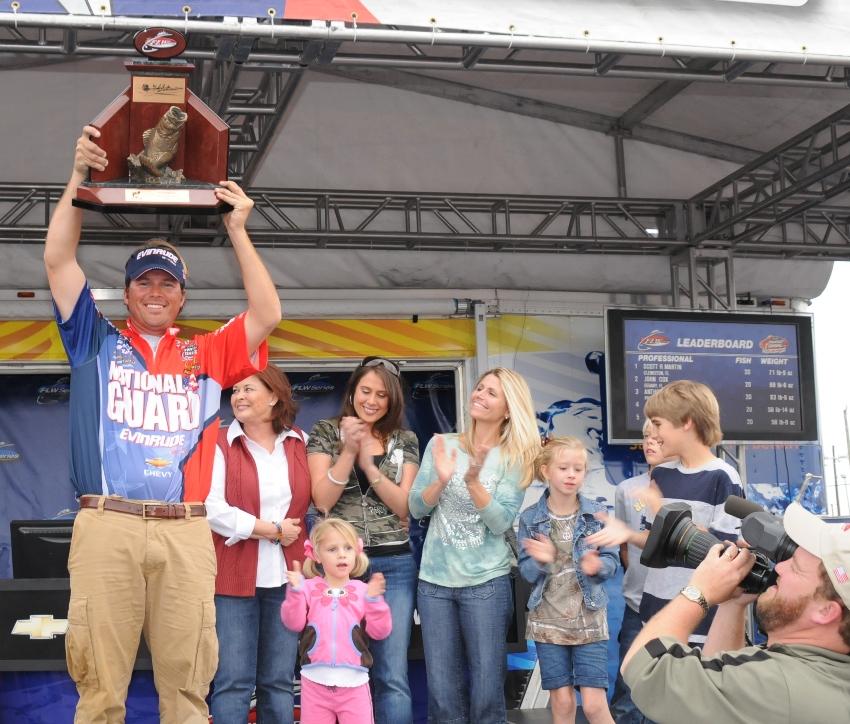
OKEECHOBEE, Fla. – If there is one thing Scott Martin of Clewiston, Fla., has wanted in his fishing career more than anything else, it’s been to win a major event on his home lake at Lake Okeechobee.
He’s been close. There was a second-place finish, fourth place, seventh place, eighth place and ninth place – all in FLW or BASS competition – but never a first.
That all changed Saturday when Martin came from behind to take advantage of a major stumble from three-day leader John Cox.
Cox carried nearly an 11-pound advantage into the final day. At weigh-in, Martin brought 20 pounds, 3 ounces to the scales for a four-day total of 71-9; Cox brought just 7 pounds, 5 ounces for a four-day total of 69-6. In the end, Martin clipped him by 2 pounds, 3 ounces.
“This is surreal,” said Martin, who collected $50,000 for the win. “It’s been a long time coming. I’ve been on tour 11 years and had plenty of opportunities to win here and could never get it done. To seal it today here, in front of all my friends and family, is really, really special. This puts me at ease, knowing I can compete at this level on this lake.”
From the beginning of the event, Martin led his targeted win like a marksman leading a clay pigeon. And today he pulled the trigger to hit his mark.
“One of the hardest lessons I’ve learned here after getting beat in the past is that sight-fishing will eventually burn you in multiple-day events on this lake,” Martin said.
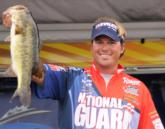
Martin contends that sight-fishing is double trouble. For one, it’s way too easy to get bogged down on a big fish or two, wasting a day on fish that just burn up the clock and then leave.
“I made that mistake twice last year and swore I’d never do it again,” he explained.
Second, continually taking nest-guarding males from a productive fishing area day after day removes the incentive for new females to move into the area.
“Colonies of nesting males on this lake are the very things that attract females to an area,” Martin explained. “Take the males, and the females move on elsewhere.”
With that knowledge in the back of his mind, Martin set a tournament-winning strategy that revolved around catching big females early in the morning on soft-plastic topwaters and swimbaits.
“For about an hour, right at first light, those big females in those nesting areas will crush anything that comes around them,” Martin explained. “But once the sun gets up, they lock on the beds and become uninterested in eating.
“Don’t get me wrong; I did sight-fish some, especially yesterday when I missed a bunch of big bites in my morning feeding window and had to resort to catching males off the bed, but there was a method to my madness – I was very selective in leaving males in certain places with hopes that they would keep pulling in females.”
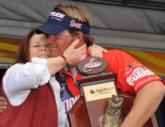 When today dawned cloudy and windy with an approaching front, Martin’s long-term strategy finally paid off. While other sight-fishing pros were running out of fish and had the “lights” turned off from dark clouds and wind, Martin’s big females were thrashing his topwater plastics reeled over the surface. He had led his target perfectly.
When today dawned cloudy and windy with an approaching front, Martin’s long-term strategy finally paid off. While other sight-fishing pros were running out of fish and had the “lights” turned off from dark clouds and wind, Martin’s big females were thrashing his topwater plastics reeled over the surface. He had led his target perfectly.
All week Martin focused on the west and east walls of Okeechobee and the Rita Island area. He targeted the thickest Kissimmee grass he could find, knowing that the more open fields would get depleted by other competitors.
His main weapons were both a Lake Fork Live Magic Shad (watermelon-red) and a Reaction Innovations Trixie Shark (June-bug). Both soft plastics were impaled on a large 7/0 Trokar hook, tied to 65-pound-test Lake Fork Hybrid Braid and cast on a 7-foot, 6-inch Kistler Helium extra-heavy-action rod.
When he did sight-fish, Martin used a Lake Fork Baby Hyperfreak creature bait (white) teamed with a tungsten 1/2-ounce weight. He tied it to 20-pound-test Lake Fork FHP (Fluoro-Hybrid Pro).
Martin also credited his double Power-Pole system for his success this week.
“There’s no way I would have won without the twin Power-Poles,” he said. “Being able to stop your boat and hold its position at any angle in any wind is an advantage that’s unbeatable. I can’t tell you how many more fish I catch because I can stop on dime and fish a hole or a bed or where a fish just blew up without drifting all on top of the spot or having to blow the area out with my trolling motor and spook the fish. Power-Poles are a must-have in my book.”
In all, this is Martin’s fourth major FLW title. His other wins include two FLW Tour titles on Lake Champlain and one on the Mobile Delta.
Cox falls to second
After leading for three days, John Cox of Debary, Fla., finished runner-up, collecting $20,000.
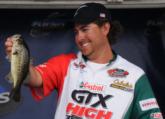
At weigh-in, one could not help but to feel Cox’s pain as he watch a perfect week slip away to declining weather, muddy water and missed opportunities.
“It was rough day,” Cox said. “Everything went wrong. My best places were filled with muddy water, and the few bites I had in my back-up areas I missed. At the end of the day, I pulled into a little pond right here off the Kissimmee River and caught five squeakers just to have something to weigh in. It was just brutal.”
Cox said the biggest key to his success during the week was looking out deeper for bass and beds that others had missed.
Many of his fish came from beds in 4 to 5 feet of water that were just barely visible, even in the best of conditions. Many times Cox could not even see the bed; he would just spot the bass and carefully watch for where it set up to give away the bed’s location.
“Lake Okeechobee is really clear this year,” Cox said. “One of the places I fished was King’s Bar, and it looks just like Lake Toho in there, with deeper, open ponds. And the bigger females were set up on beds the same way they set up at Toho – out deep where you can barely see them.”
Cox’s key baits during the week included a Berkley Power Worm, a Power Bait Craw and a Power Bait Crazy Leg Chigger Craw.
Gagliardi takes third
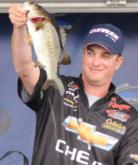
Chevy pro Anthony Gagliardi finished third with a four-day total of 63-6. He collected $15,000 for the week.
Gagliardi devoted much of his week to sight-fishing close to the Kissimmee River area of Okeechobee.
His key baits included white plastic craws, soft jerkbaits and swimbaits.
“An important part of sight-fishing on Okeechobee is to move really slowly when looking for beds,” Gagliardi offered. “These fish can camouflage themselves in the grass so well you’ll never even know they’re there. So you have to kind of creep along in those grass flats and train your eye to detect any kind of movement in the water.
Tucker takes fourth
J. Todd Tucker of Moultrie, Ga., finished fourth with a four-day total of 58-14 worth $10,000.
Tucker fished on the North Shore for his better fish, including his 21-9 limit on day three.
Interestingly, Tucker used a unique approach to find and catch untapped fish this week. Instead of fishing out in the eelgrass where others were fishing, Tucker used his big engine and push pole to force himself inside the reed line on the North Shore.
“I us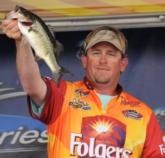 ed my outboard to push my way in there, looking for any small holes or open spots,” Tucker said. “If there were any openings back there, it usually had a big bed or two in it with fish. The biggest key was to find open, clean bottom back in those reeds. If it was clogged up with hydrilla and eelgrass behind the reeds, it was no good. But if it was a clean bottom with mussel shells, there would be beds back there.”
ed my outboard to push my way in there, looking for any small holes or open spots,” Tucker said. “If there were any openings back there, it usually had a big bed or two in it with fish. The biggest key was to find open, clean bottom back in those reeds. If it was clogged up with hydrilla and eelgrass behind the reeds, it was no good. But if it was a clean bottom with mussel shells, there would be beds back there.”
Many of Tucker’s bass were paired up, and he faced the challenge of catching the female without catching the male.
“I’ve learned in Florida that if you catch the male, the female will leave,” he explained. “Now it may be different in other parts of the country, where when you catch the male the female will set up on the bed after he is gone, but that’s not the case here.”
In order to avoid catching the males, Tucker employed a large 8-inch swimbait to “tease the pair.”
“At first, the male would come after it, but they are usually so small they wear themselves out charging after it,” he described. “Pretty soon the female would get tired of the male not doing its job, and she would set up in the bed to defend it. That’s when I’d drop a tube or Brush Hog in there and catch her.”
Today, dark clouds put a damper on his sight-fishing game plan, and he moved out the outside of the eelgrass and targeted schooling bass under diving birds with a ¼-ounce Rat-L-Trap and a spinnerbait.
“I caught 150 fish today,” Tucker said. “It was unreal. In the last hour of the day, I caught a fish on every cast I made. This lake is incredible. If you want to introduce a kid to fishing, this is the place to come. Just ride around on the outside of the eelgrass, looking for diving birds, and cast underneath them – there are thousands of bass schooling on shad out there.”
Mann rounds out top five
Chalk up yet another top-five finish for Tom Mann Jr. of Buford, Ga., who claimed the fifth spot with a four-day total of 58-5 worth $9,000.
This week Mann fished the Big Grassy and King’s Bar areas for his catches.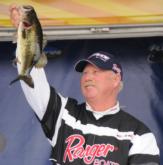
He alternated between blind-casting a 5-inch Yamamoto Senko (watermelon-red) on 17-pound Suffix fluorocarbon and sight-fishing a Yamamoto tube (camouflage) when he came across beds with better fish.
“Fishing Lake Okeechobee in January, when the weather is warm, is not that big of a secret,” Mann offered. “Look around the lake until you find shallow areas with mixed vegetation with shells, light spots and beds on the bottom; Texas-rig a watermelon-red Senko with a 5/0 VMC offset hook, cast it out there and have a ball. It’s some of the finest fishing you can do.”